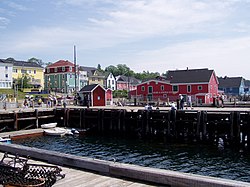Lunenburg County, Nova Scotia
County in Nova Scotia, Canada From Wikipedia, the free encyclopedia
Lunenburg County is a historical county and census division on the South Shore of the Canadian province of Nova Scotia. Major settlements include Bridgewater, Lunenburg, and Mahone Bay.
Lunenburg County | |
|---|---|
 Lunenburg harbourfront | |
| Nickname: "Christmas Tree Capital of the World"[1] | |
 Location of Lunenburg County, Nova Scotia | |
| Coordinates: 44.5°N 64.5°W | |
| Country | Canada |
| Province | Nova Scotia |
| District municipalities | Chester / Lunenburg |
| Towns | Bridgewater / Lunenburg / Mahone Bay |
| Established | August 17, 1759 |
| Divided into District Municipalities | April 17, 1879 |
| Electoral Districts Federal | South Shore–St. Margaret's |
| Provincial | Chester-St. Margaret's / Lunenburg / Lunenburg West |
| Area | |
| • Land | 2,906.47 km2 (1,122.19 sq mi) |
| Population | |
• Total | 48,599 |
| • Density | 16.7/km2 (43/sq mi) |
| Time zone | UTC-4 (AST) |
| • Summer (DST) | UTC-3 (ADT) |
| Area code | 902 |
| Dwellings | 24,786 |
| Median Income* | $43,257 CDN |
| |
History
Named in honour of the British king who was also the duke of Brunswick-Lüneburg, it was established in 1759, when the Nova Scotia peninsula was divided into five counties. The county became smaller when new counties were created from its boundaries: Queens (1762), Hants (1781), Shelburne (1784), and Sydney (1784).
By Chapter 52 of the Statutes of 1863, Lunenburg County was divided into two districts for court sessional purposes – Chester and Lunenburg. That statute provided authority for the appointment of a Custos Rotulorum and for the establishment of a general sessions of the peace for the District of Chester, with the same powers as if it were a separate county. In 1879, the two districts were incorporated as district municipalities.
Governance
Today the county has no legal status, although its borders are coincident with the five municipalities contained within it:
- the municipality of the District of Chester
- the municipality of the District of Lunenburg
- the town of Bridgewater
- the town of Lunenburg
- the town of Mahone Bay
The above municipalities comprise the entire territory of the county.[4]
There are three Sipekneꞌkatik First Nation reserves in the county:
Demographics
Summarize
Perspective
As a census division in the 2021 Census of Population conducted by Statistics Canada, Lunenburg County had a population of 48,599 living in 22,443 of its 27,092 total private dwellings, a change of 3.1% from its 2016 population of 47,126. With a land area of 2,906.47 km2 (1,122.19 sq mi), it had a population density of 16.7/km2 (43.3/sq mi) in 2021.[5]
|
Mother tongue language (2011)[8]
|
Ethnic Groups (2006)[9]
|
Religious make-up (2001)[10]
|
Access routes
Highways and numbered routes that run through the county, including external routes that start or finish at the county boundary:[11]
See also
- List of communities in Lunenburg County, Nova Scotia
- List of communities in Nova Scotia
- Lunenburg English, the distinctive dialect of the area
References
External links
Wikiwand - on
Seamless Wikipedia browsing. On steroids.
